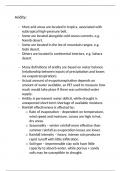Summary
Summary Arid environments A* revision notes for CIE A level Geography
- Institution
- CIE
Thorough revision notes for the 'Hot arid and semi-arid environments' component of CIE A2 advanced physical geography, with case study detail included at relevant points. The notes have been constructed by referencing Garrett Nagle and Paul Guinness' revision guide for the course, as well as class ...
[Show more]




